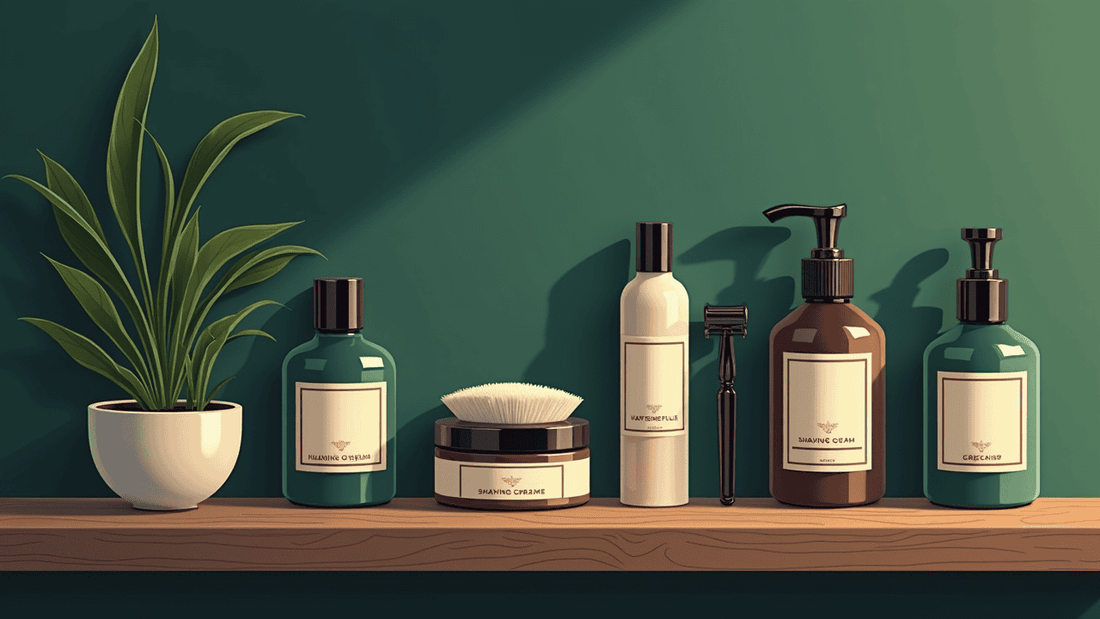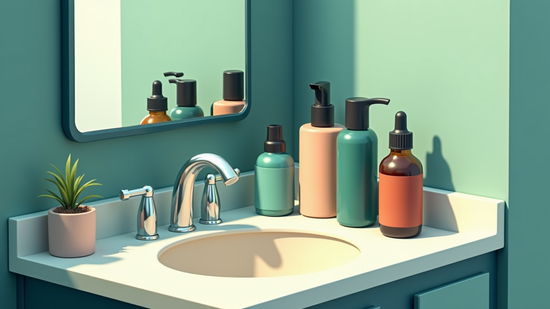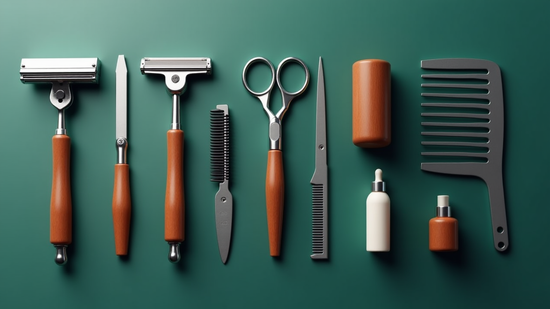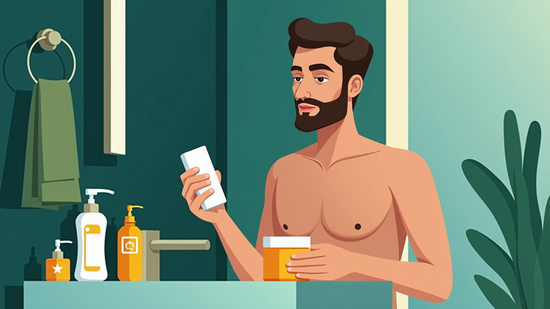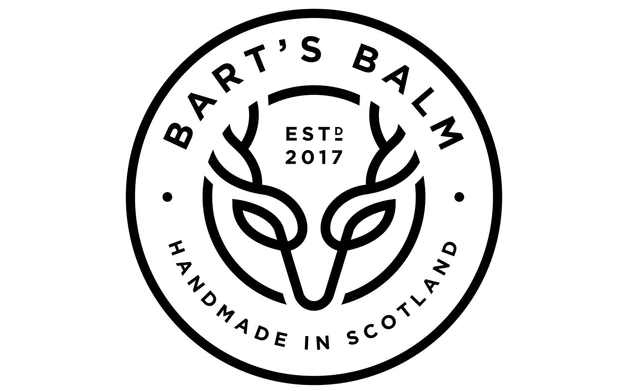Rediscovering the art of shaving can transform a mundane daily routine into a delightful self-care ritual. In a world filled with fast-paced lifestyles and quick fixes, there’s something uniquely satisfying about returning to the age-old tradition of using handmade products and distinctive fragrances. Not only does this approach elevate the shaving experience, but it also nurtures the skin and soul, merging luxury with practicality.
Imagine the sensation of a warm lather, the rich aroma of essential oils wafting through the air, and the ritualistic feel of a well-crafted razor gliding over your skin. These moments go beyond mere grooming; they represent a space for self-reflection and personal care. In this article, we will journey through the history of shaving, explore the benefits of handmade products, and delve into the unique fragrances that enhance this timeless practice.
As he or she reads on, they will find tips on perfecting their shaving technique, insights into choosing the right products, and an appreciation for the sensory experience of a traditional wet shave. Embrace this opportunity to refine your shaving routine, honor the art of grooming, and rediscover the enjoyment that comes with thoughtfully chosen, handmade products.
The History of Shaving
Shaving is more than just a daily grooming ritual; it carries centuries of tradition and cultural significance. Understanding its history can reveal fascinating insights into humanity's evolving relationship with appearance and hygiene. Let's explore the journey of shaving, from ancient practices to modern innovations.
Early Shaving Practices
In ancient civilizations, shaving was not merely a cosmetic choice but often a reflection of social status and identity. Early humans utilized rudimentary tools to remove facial hair, marking the beginning of a practice that would evolve over millennia.
- Stone Age Implements: The first known shaving tools were likely made of sharpened stones or shells. Archaeological evidence suggests that as early as 30,000 B.C.E., men were using these primitive methods to trim their beards.
- Egyptian Innovations: The Egyptians are credited with developing more sophisticated shaving techniques around 3000 B.C.E. They crafted tools from bronze and later iron. Shaving was a sign of cleanliness and was closely associated with nobility, as many pharaohs were depicted clean-shaven in their monumental artwork.
- Cultural Connections: In many cultures, beards and facial hair had deep symbolic meanings. For instance, in ancient Mesopotamia, beards were considered a mark of masculinity and power, while in other regions, shaven faces represented wisdom and purity.
These early practices laid the groundwork for the diverse traditions surrounding shaving that would follow, revealing the intricate relationship between grooming and societal norms.
Evolution of Shaving Tools
Over the centuries, shaving tools have undergone remarkable transformations, reflecting advancements in technology and changes in societal attitudes towards grooming.
- Straight Razors: The 17th century saw the introduction of straight razors, significantly improving the shaving experience. Made from fine steel, these razors required skill and upkeep but offered a close shave that was highly sought after.
- Safety Razors: The late 19th century brought about the safety razor, a game-changer for home shaving. With a protective guard to prevent cuts, it made shaving more accessible and less intimidating for the general public. This innovation opened the door for widespread grooming habits.
- Electric Razors: The 20th century introduced electric razors, revolutionizing personal care. They offered convenience and ease of use, appealing especially to those with busy lifestyles. This evolution has continued, with advancements in battery life, design, and cutting technology enhancing the shaving experience.
As tools became more user-friendly, the once intricate art of shaving became a routine part of daily life for many, allowing individuals to personalize their grooming habits.
Cultural Significance of Shaving
Shaving practices can significantly vary across cultures, displaying a wide array of beliefs, rituals, and social norms that go beyond mere aesthetics.
- Ritualistic Elements: In various cultures, shaving is intertwined with significant life events. For example, in some South Asian countries, a boys' first shave, known as "mundan," symbolizes their transition into adulthood.
- Religious Contexts: Many religions incorporate shaving into their rituals. For instance, Sikh men are encouraged to maintain their uncut hair, whereas monks in some Buddhist traditions shave their heads as a sign of renunciation.
- Fashion and Identity: In modern society, shaving styles can be a matter of personal expression. Beards and clean-shaven faces can convey different messages – from professionalism to artistic identity. The current trend of grooming reflects both individual choice and societal influences, allowing people to align their appearance with their personal beliefs and lifestyles.
Understanding these various dimensions underscores that shaving is far more than a grooming chore; it is an intricate practice laden with cultural meaning and historical significance, reflecting the evolving tapestry of human life.
Through centuries of evolution, from the use of basic tools to the sophisticated razors of today, the history of shaving presents a fascinating example of how a simple practice can shape identities and societies.
Benefits of Handmade Shaving Products
Handmade shaving products have gained a dedicated following among grooming enthusiasts who recognize the unique benefits these artisanal creations provide. Unlike mass-produced alternatives, handmade products often emphasize quality and care, resulting in a more delightful and effective shaving experience. Let’s delve into some of the key advantages of choosing handmade shaving products.
Natural Ingredients and Skin Health
One of the standout features of handmade shaving products is their emphasis on natural ingredients. Many artisanal brands prioritize skin health by crafting formulations that are gentle and nourishing.
- Minimal Chemical Exposure: Handmade products typically avoid harsh chemicals and synthetic additives, reducing the risk of skin irritation and allergies.
- Natural Oils and Butters: Ingredients such as shea butter, coconut oil, and essential oils are often utilized, providing hydration while promoting healthy skin.
- Vitamins and Nutrients: Many artisans infuse their products with vitamins and botanicals that can soothe and protect the skin, enhancing the overall shaving experience.
For those with sensitive skin, opting for products made with natural ingredients can lead to noticeable improvements in comfort and skin health.
Artisanal Techniques and Craftsmanship
Handmade shaving products are often crafted with care and attention to detail, resulting in a level of craftsmanship that is hard to replicate in the mass production of budget brands.
- Unique Scents and Textures: Artisans often experiment with different blends, leading to distinctive scents and textures that can’t be found in conventional products. Each batch can reflect the creator’s personality and passion.
- Personal Touch: The process of making handmade products allows for a personal connection between the maker and the consumer. This connection often leads to products that reflect a commitment to quality and a passion for the craft.
- Quality Over Quantity: Because they are often made in smaller batches, each product receives more focus and care, ensuring higher quality and consistency.
This level of craftsmanship means users can enjoy a more luxurious and personalized grooming routine.
Sustainability and Environmental Impact
In today’s eco-conscious world, sustainability is a significant concern for many consumers. Handmade shaving products often align more closely with environmental values compared to their mass-produced counterparts.
- Eco-Friendly Ingredients: Many artisans choose sustainable, organic ingredients that are better for the planet. This choice not only supports sustainable agriculture but also reduces the environmental footprint.
- Minimal Packaging: Handmade products frequently come in minimalistic or biodegradable packaging, further reducing waste compared to conventional shaving products that may utilize excessive plastics.
- Support for Local Economies: Purchasing handmade products often means supporting local artisans and small businesses, contributing positively to local economies and fostering community well-being.
By opting for sustainable, handmade shaving products, consumers can make a choice that is kind to both their skin and the planet.
The appeal of handmade shaving products goes beyond the basic function of shaving; it encompasses aspects of health, craftsmanship, and sustainability. Those who choose these products often find a richer, more satisfying experience that supports their individual values and needs. Those interested can explore a range of artisanal options to discover a shaving routine that resonates personally and holistically.
Unique Fragrances in Shaving Products
In the world of personal grooming, fragrance plays a pivotal role that goes beyond mere olfactory pleasure. A well-chosen scent can enhance a person's confidence, evoke memories, and even influence perceptions. When it comes to shaving products, the importance of fragrance is multi-faceted:
- Boosts Confidence: A fresh, appealing fragrance can uplift a person's mood and help them feel more self-assured throughout their day.
- Establishes Identity: Scents often become part of a person’s signature, subtly communicating their personal style and preferences to others.
- Creates a Sensory Experience: The act of shaving can become more than just a routine chore; a delightful fragrance elevates the ritual, turning it into an enjoyable, mindful experience.
The right fragrance in shaving products can transform a basic grooming routine into an immersive experience, one that delights the senses and reinforces an individual’s grooming regimen.
Exploring Essential Oils and Natural Scents
Natural fragrances, particularly those derived from essential oils, are gaining traction among grooming enthusiasts. These botanical extracts offer a plethora of benefits that cater not only to the sense of smell but also to skin health.
- Lavender: Known for its calming properties, lavender essential oil can soothe the skin and mind, making shaving a more relaxing experience.
- Peppermint: Its refreshing scent invigorates the senses while providing an element of cooling during and after the shave.
- Tea Tree: Renowned for its antiseptic qualities, tea tree oil not only smells great but also helps prevent post-shave irritation and breakouts.
Incorporating essential oils into shaving products not only enriches the fragrance profile but also enhances the overall grooming experience by promoting skin health.
Customized Fragrance Blends
With the rise of personalization in grooming products, customized fragrance blends have become an exciting opportunity for those seeking a unique touch in their shaving routine. Many brands now offer the option to create bespoke scents tailored to individual preferences.
- Consultation Services: Some companies provide personalized consultations, where customers can discuss their scent preferences and receive expert recommendations.
- Layering Scents: This technique allows users to mix and match scents, creating a unique fragrance profile that sets them apart.
- Seasonal Blends: The option to switch fragrances based on changing seasons adds a dynamic element to grooming, keeping routines fresh and innovative.
The trend toward customized fragrances not only caters to individual tastes but also enhances the connection between personal grooming and self-expression. Choosing a unique fragrance blend offers a chance for users to embody their character and enhance their daily grooming ritual.
The Shaving Ritual: Techniques and Tips
Shaving is more than just a daily task; it’s a time-honored ritual that, when performed correctly, can transform routine grooming into a rejuvenating experience. The key to achieving that perfect shave lies in understanding the essential techniques and tips that can elevate this process. Below, we explore the different aspects of the shaving ritual, ensuring that both novices and seasoned individuals can enhance their shaving experience.
Preparing Your Skin for Shaving
Before reaching for the razor, proper preparation of the skin is essential. Taking a few moments to prepare can significantly improve the comfort and quality of the shave. Here are some crucial steps to consider:
- Hydration: Wetting the skin with warm water softens both hair and skin, making shaving smoother. Consider taking a warm shower or using a warm, damp towel on your face for a few minutes.
- Exfoliation: Gently exfoliating the skin removes dead skin cells and unclogs pores, allowing for a closer shave. This step can minimize the risk of ingrown hairs and irritation.
- Shaving Cream/Gel: Using a quality shaving cream or gel can provide a protective barrier between the skin and the razor. Look for products containing moisturizing agents and soothing ingredients like aloe or tea tree oil for comfort.
Using the Right Tools for the Perfect Shave
Having the right tools is fundamental to achieving an effortless shave. Here’s what to keep in mind:
- Razor Selection: Choosing between a safety razor, straight razor, or cartridge razor depends on personal preference. Each tool offers a unique experience, so it’s worth trying different types to find what feels best.
- Blade Quality: Ensure that the razor blade is sharp and clean. Dull blades can tug at the hair, leading to discomfort and irritation. It’s important to replace blades consistently to maintain cutting effectiveness.
- Brush Use: Utilizing a shaving brush can enhance lathering, allowing the cream or soap to better penetrate the hair and skin. It also helps lift the hair for a closer shave and exfoliates the skin.
Aftercare and Maintaining Skin Health
Post-shave care is crucial for maintaining skin health and preventing irritation. Following these aftercare tips will help keep the skin looking and feeling its best:
- Rinsing with Cold Water: After shaving, rinsing the face with cold water helps close pores and reduces the risk of irritation.
- Moisturizers: Applying a soothing aftershave balm or moisturizer can help hydrate the skin and alleviate any discomfort. Look for products rich in calming ingredients like chamomile or vitamin E.
- Sun Protection: If shaving is part of a morning routine, applying a sunscreen is vital. Shaved skin can be more sensitive to UV rays, so protecting it helps maintain overall skin health.
Crafting a shaving ritual with these techniques and tips can turn a mundane task into a satisfying and refreshing experience. By preparing the skin properly, using the right tools, and following through with diligent aftercare, individuals can not only achieve a close shave but also promote healthier skin. This series of steps enhances the overall experience, ensuring that it is something to look forward to, rather than a chore.
Choosing the Right Handmade Shaving Products
When it comes to grooming, choosing the right handmade shaving products can make a significant difference in the experience and results. With a vast array of options available in the market, it's essential to be informed and intentional about the products selected. Let's explore the key factors involved in making the best choices for a comfortable and effective shave.
Identifying Quality Ingredients
Quality is paramount when it comes to handmade shaving products. Often, the ingredients used can determine not just performance but also skin health. Here are some aspects to consider when assessing the ingredients:
- Natural Oils: Look for products that contain natural oils, such as jojoba oil, coconut oil, or almond oil. These ingredients help moisturize the skin and provide a smooth glide for the razor.
- Essential Oils: While they add fragrance, essential oils like tea tree or lavender also offer antibacterial properties and soothing effects on the skin.
- Avoid Harsh Chemicals: Handmade products are often celebrated for their lack of synthetic ingredients. Consumers should look for items free from sulfates, parabens, and artificial fragrances to prevent irritation.
- Organic Certifications: Products that highlight organic certifications tend to be more reliable in terms of ingredient quality. They often avoid pesticides and synthetic fertilizers, which can be beneficial for sensitive skin.
By scrutinizing product labels and prioritizing quality ingredients, one can ensure a better shaving experience while caring for the skin.
Understanding Different Types of Products
The variety of shaving products can be overwhelming, so understanding their differences is key. Here’s a breakdown of common types and what they offer:
| Type of Product | Description | Benefits |
|---|---|---|
| Shaving Soap | A solid that requires water to lather | Traditional, often lasts longer, offers a close shave |
| Creams | Creamy texture that lathers easily | Convenient, great for sensitive skin |
| Balm | Post-shave product for soothing irritation | Moisturizing, helps reduce redness |
| Gels | Clear, slick product ideal for visibility | Excellent for precision shaving |
Each product offers unique benefits, and selecting the right type often depends on individual shaving preferences and desired results.
Personal Preferences and Skin Types
Personal preferences and skin types play a crucial role in selecting handmade shaving products. Here are some tips for finding the right fit:
- Consider Skin Type: Sensitive skin may require lighter, alcohol-free products that reduce irritation, while oily skin can benefit from products that help manage excess oil.
- Assess Hair Type: Thicker hair may need a more robust product designed to provide a better grip, while finer hair may not require as much lubrication.
- Fragrance Sensitivity: Some individuals are sensitive to fragrances and may prefer unscented products. Testing a small amount of a new product can help avoid potential allergic reactions.
Ultimately, choosing the right handmade shaving products is a personal journey that balances quality, effectiveness, and comfort. By prioritizing quality ingredients, understanding product types, and acknowledging personal skin needs, one can find the perfect match for a pleasant shaving routine.
The Experience of a Traditional Wet Shave
In today's fast-paced world, the allure of convenience often reigns supreme. Many individuals opt for quick, electric shaves that promise efficiency but can sometimes sacrifice quality. However, the experience of a traditional wet shave invites one to slow down and savor each moment. The process itself becomes a ritual, a distinct departure from the hustle and bustle of everyday life.
- Ritualistic Nature: Each step, from preparing the tools to the final rinse, lends itself to a heightened sense of mindfulness.
- Quality over Quantity: Instead of cutting corners, traditional wet shaving emphasizes the art of grooming, encouraging a more thorough and careful approach.
Choosing to embrace the traditional method can evoke feelings of nostalgia and appreciation for craftsmanship, leading to a deeper personal connection throughout the shaving experience.
The Sensory Experience of Wet Shaving
A traditional wet shave is more than just a grooming routine; it is a sensory journey. Engaging multiple senses allows for an immersive experience that contrasts sharply with the utilitarian nature of modern shaves.
- Visuals: The elegance of a well-crafted straight razor or a classic safety razor can be visually striking. The artistry and detail in these tools invite admiration even before use.
- Textures: The rich, creamy lather of high-quality shaving soap or cream applied with a brush adds a tactile element that elevates the process, making the skin feel nourished.
- Aromas: The delightful scent of shaving soaps, often infused with essential oils or natural fragrances, enhances the experience, wrapping the individual in a comforting embrace.
As they glide the razor across their skin, the user feels the smoothness and precision resulting from their careful preparation, turning a routine into a moment of pure pleasure and indulgence.
Enjoying Time for Self-Care
In an era where self-care often gets overlooked, the traditional wet shave serves as a gentle reminder of the importance of taking time for oneself. It allows individuals to carve out personal moments amid a busy schedule, cultivating a sense of well-being.
- Mental Clarity: The act of focusing on the shave can clear the mind, offering a pause from daily stresses and responsibilities.
- Connection with Tradition: Engaging in this time-honored practice fosters a connection to generations past, allowing individuals to feel a part of a larger narrative.
- Self-Pampering: Investing time in a traditional wet shave aligns with self-care principles. The ritual can instill a sense of pride and accomplishment, further boosting one’s mood.
Through this intentional act, the individual not only cares for their appearance but also nurtures their mental and emotional health, making the traditional wet shave a worthwhile endeavor in the realm of personal grooming.
Conclusion
Rediscovering the art of shaving is a journey back to craftsmanship, health, and self-care. By embracing handmade shaving products, individuals unlock not just superior performance but also the joy found in unique fragrances and sustainable practices. For those looking to elevate their shaving experience, Bart's Balm offers a range of handmade aftershave balms, pre-shave balms, and Eau De Parfums that beautifully combine quality and delightful scents. With over 25 years in the industry, customers can trust Bart's Balm for their grooming needs. Explore the collection and transform your routine today at Bart's Balm.
Frequently Asked Questions
-
What are the benefits of using handmade shaving products?
Handmade shaving products often contain natural ingredients that are gentler on the skin, providing a smoother shave while minimizing irritation. They are crafted with care, typically free from harmful chemicals found in mass-produced alternatives.
-
How do unique fragrances enhance the shaving experience?
Unique fragrances can transform the shaving routine into a pleasurable ritual. They provide a refreshing, invigorating scent that can elevate your grooming experience, boost your mood, and leave a lasting impression throughout the day.
-
Are handmade shaving products suitable for sensitive skin?
Yes, many handmade shaving products are specifically formulated for sensitive skin. They often avoid synthetic fragrances and harsh chemicals, using natural ingredients that nourish and protect sensitive skin during shaving.
-
What types of handmade shaving products should I consider?
Consider products like handmade shaving soaps or creams, natural aftershaves, pre-shave oils, and artisanal shaving brushes. These products typically offer superior quality and can improve your overall shaving experience.
-
How can I choose the right fragrance for my shaving products?
Choosing the right fragrance depends on personal preference. Consider scents that align with your personality, lifestyle, and the occasion. It's also advisable to select complementary products that have similar fragrance notes for a harmonious grooming experience.


